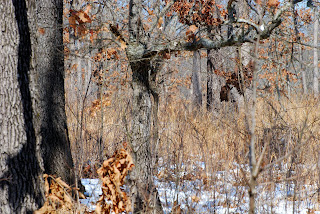Winter is a good time to begin assessing your property for its value to wildlife especially quail. Winter is often the time when habitat for many species is limiting. With the leaves now off of trees and plants no longer growing you can get a better picture of your property. Here is an exercise you can try on your property to get an idea of how small wildlife species like a quail might view your property. Lie down on the ground in your pasture, woods, or crop field and look around. Is your vision obstructed or can you see a long distances until a change in topography obscures your view. Would you feel safe here? How far would you have to run or fly to get to cover? If you had to escape a predator are there multiple escape routes or are you limited to only one thicket of shrubs or patch of cover? Run this exercise for all the habitats on your property from multiple points. Ideally you should have multiple escape routes or thickets no further than 100 ft and your vision should be obstructed in multiple directs to a height of at least 24 inches.
Now walk over to your escape cover and study it. Is it a brush pile, shrub thicket, or dense stand of native grass? Imagine you dropped your keys into the middle of it. Would you feel comfortable reaching down into it and not be afraid of getting scratched, poked, or cut? Would it be easy to see your keys in the cover? Could you lie down on the ground and reach into the middle of it from multiple directions? If so then your escape cover is not adequate to protect quail or other small wildlife species from predators.
Walk over to any idle grass field. Does it have a mix of grasses and wildflowers (weeds) or is it a pure stand of grass? Has it been burned or disked in the last 2 to 3 years? If not walk out into the middle of it, take your foot and slide it 6 inches along the ground. Can you still see it or does it disappear into at least 12 inches of vegetation? If it disappears you may have some good thermal and aerial obstruction cover. Now toss your hat over your shoulder and repeat the test where your hat lands. After each test toss of your hat repeat the test. Repeat the test a number of times across the field. Half of your plots should allow your foot to disappear completely. If it is less than 30 % then you cover is probably too thin. If it is more than 75% then your cover is probably too thick.
Next from several points shuffle your feet along the ground. Don’t lift them. You should be able to maneuver yourself around clumps of grass or thickets without lifting your feet. Did you have a lot of vegetation get wrapped around you feet and ankles? If you feet get entangled in a lot of vegetation from previous years then the thatch layer is too thick. More than likely if there is too much thatch build up your legs will become sore from the resistance of the vegetation as you shuffling your feet. If your feet become entangled in thatch and you really cannot move then your cover is too thick for quail and other small wildlife.
If your habitat is too sparse or too thick it is not good for wildlife. If you do not have enough escape cover predators can pick off any quail that ventures onto your property. You need to manage your habitat for wildlife so that everything is just right in order to help improve their survival. If you need additional help you should seek out a private lands biologist that will be able to provide you with guidance on correcting the habitat issues on your property.


No comments:
Post a Comment